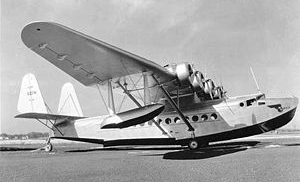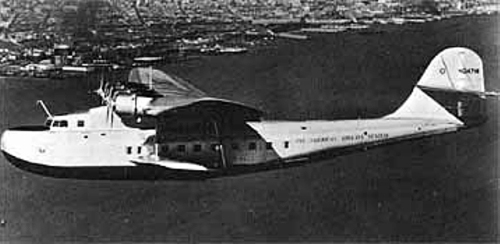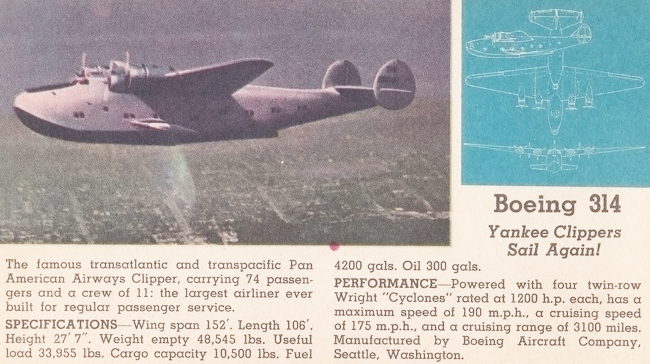China Clipper
Today, a brief bright moment. The University of Houston's College of Engineering presents this series about the machines that make our civilization run, and the people whose ingenuity created them.
I first experienced airline luxury in May, 2011. I flew from Houston to Qatar to give some talks. Before that I'd flown only in coach. Now Qatar Airways took me non-stop over eight thousand miles with fine food, lots of room, a bed to sleep in ...
It was a surreal experience. You see, I'd dreamt all my life about flying the once-famous China Clipper across the ocean. It was my imagined gold standard for luxury in the air.
 That magic carpet of the air began when Pan American Airlines set out to build a fleet of trans-oceanic seaplanes in 1931. Three years later, they put Sikorsky's four-engine Flying Clipper into service. Ten were made. They carried as many as 37 passengers (or 14 with berths) and had roughly a 2000 mile range.
That magic carpet of the air began when Pan American Airlines set out to build a fleet of trans-oceanic seaplanes in 1931. Three years later, they put Sikorsky's four-engine Flying Clipper into service. Ten were made. They carried as many as 37 passengers (or 14 with berths) and had roughly a 2000 mile range.
Then the Martin Company entered with a new seaplane. They named it China Clipper. They built two more for Pan AM and one for Russia. They had a 3200-mile range and gave a similar number of passengers even greater comfort.

The Martin M-130, first to carry the name China Clipper
The one-way China Clipper fare from San Francisco to the Philippines, by way of Hawaii, Midway, Wake, and Guam, was $700 -- the equivalent of around $12,000 today. And its 2-1/2 day journey touched imaginations. (Never mind that its first navigator was the same Fred Noonan who later perished with Amelia Earhart.)
Pan Am liked the name China Clipper so it became a generic term for all its big flying boats -- even though each had its own name. Finally, Boeing made a really fancy China Clipper with a 3700 miles range. It could carry 36 passengers with sleeping compartments.

The Boeing 314 version of the Clipper. This image is from a 1940/42 airplane spotter's book,Airplanes of the U.S.A. (Racine, WI, Whitman Pub. Co., 1940/42): pg. 14. On page 18, the book also shows a Sikorsky VS-44-A huge seaplane, three of which were built during WW-II.
So what became of that fleet? Out of Pan Am's 25 China Clippers, six, crashed -- a pretty grim record. During WW-II, the rest were put into military service where many more crashed. And, as our experience with long range civilian aircraft was put to use in bombers, we realized something: When an airplane has transoceanic range, the large aerodynamic cross-section of a seaplane only slows it down. The day of globe-trotting seaplanes was done.
China Clippers were in fact noisy, tiring, and dangerous. They remind us of their namesakes, the Clipper Ships -- fast and dangerous ships that carried small cargos. The price of tea was briefly high enough that it paid to carry a small load very fast. But, like the China Clippers, they too also lasted only a decade.
Yet both remain the stuff of dreams -- like their cousins, the great dirigibles. Dirigibles also keep playing with our imaginations, doomed as they were by another set of practical limitations.
And I think of my luxurious flight to Qatar. While it far outran the comforts of the China Clipper, it was no longer exotic. Still, modern air travel serves us just because the embryonic airlines once gambled on quixotic visions of transoceanic splendor.
I'm John Lienhard, at the University of Houston, where we are interested in the way inventive minds work.
M. Sharpe, Biplanes, Triplanes and Seaplanes. (New York: Barnes and Noble, Inc. 2000): pp. 244 and 284.
See also the Wikpedia pages for the Sikorsky S-40 -- the 1931 precursor to the Pan Am Clippers, the Sikorsky S-42, S-42A, and S-42B -- the first 10 Pan Am Clippers which began service in 1935, the Martin M-130 China Clipper, Hawaii Clipper, and the Philippine Clipper -- which began service in late 1935 and 1936, and finally the Boeing 314 -- of which 12 were made for Pan Am between 1938 and 1941.
One may also find many more websites by Googling terms from above. Sikorsky and Martin images are courtesy of Wikimedia Commons.
This episode was first aired on July 25, 2011